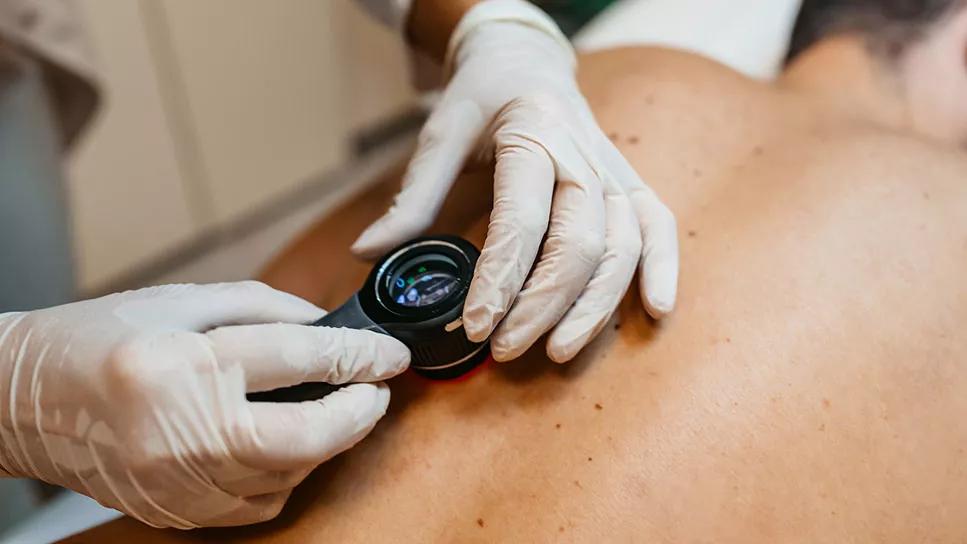The size, shape and color of moles may offer clues that point to melanoma

Sometimes, you look at a mole and think, “That doesn’t look quite right.” Don’t ignore those suspicions. There’s a chance what you see may be a sign of melanoma, a dangerous form of skin cancer.
Advertisement
Cleveland Clinic is a non-profit academic medical center. Advertising on our site helps support our mission. We do not endorse non-Cleveland Clinic products or services. Policy
So, that leads to an obvious question: How can you tell if a mole might be cancerous? It turns out there are definite hints visible to the naked eye.
Dermatologist Christine Poblete-Lopez, MD, explains how to spot potential trouble.
Moles aren’t unusual. In fact, most adults have between 10 and 40 of them scattered around their bodies. These so-called “beauty marks” are typically harmless and nothing to worry about either.
But the following variations may indicate the development of melanoma and deserve a closer look by a healthcare professional.
Certain characteristics of a mole can offer hints when it comes to melanoma. Dr. Poblete-Lopez says the rule of thumb in dermatology is to consider the ABCDEs.
Advertisement
It’s important to note that hitting on any of the ABCDE criteria doesn’t guarantee melanoma in a mole. But the indicators do signal an increased possibility of skin cancer.
Nearly 70% of melanomas begin as a new mole, which is why any mole that randomly appears deserves your attention. (This is especially true if the new mole checks boxes on the ABCDE list noted above.)
To be clear, though, not all new moles are cancerous. Most are benign and nothing more than a new mark on your skin. But that doesn’t mean they should be ignored.
“It’s best to get new moles checked by your healthcare provider,” advises Dr. Poblete-Lopez.
Moles can become itchy for a variety of reasons. It might be something as simple as dry or irritated skin, for example, or an allergic reaction to whatever laundry detergent you just picked up.
But there’s also a chance it could be a sign of melanoma, says Dr. Poblete-Lopez. Concerns increase if the mole bleeds or begins to ooze.
Bottom line? Get it looked at by a medical professional sooner rather than later.
For someone with a lot of moles, healthcare professionals often look for atypical moles and so-called “ugly ducklings” that stand out and look different. These moles often check more of the ABCDE characteristics.
The good news? It’s extremely rare for the average atypical mole to transform into melanoma. The risk is estimated at 1 in 10,000.
But increased numbers of atypical moles on your body raise your skin cancer risk. If you have 10 or more atypical moles, you’re statistically 12 times more likely to eventually develop melanoma.
It’s common for people with atypical moles to see a dermatologist regularly to monitor them for changes. Magnifying devices are often used to check for abnormalities invisible to the naked eye.
“What we find under the microscope will guide how aggressive we’ll need to be in checking your moles,” explains Dr. Poblete-Lopez. “If you’ve got a higher chance of developing cancer based on what we see, we may suggest checkups every six months instead of every year or two.”
Early detection is key to treating melanoma. Dr. Poblete-Lopez recommends doing skin self-checks once a month. Use the time to look for new moles and examine existing moles for anything unusual. Talk to your healthcare provider about any concerning findings.
Regular visits to a dermatologist may be warranted if you’re at increased risk for developing melanoma. Risk factors include:
Advertisement
Melanoma is one of the most common forms of cancer in the United States, representing 5% of all new cancer diagnoses. Case counts have been steadily rising for decades, too, reports the National Cancer Institute.
“The beauty of dermatology is that we can quickly see if there’s a problem on the surface and then do a skin biopsy, a simple in-office procedure,” reassures Dr. Poblete-Lopez. “We may be able to find anything that’s trouble early on.”
Advertisement
Learn more about our editorial process.
Advertisement

Bathing once a day is the general guidance, but you could also have reasons to soap up twice a day or not at all
There’s not one specific cure-all diet for eczema, but it helps to keep track of what you eat and when you experience symptoms

It’s best to avoid picking at zits, which can damage your skin (though there are ways to minimize the risk)

Both inflammatory conditions have varying triggers and symptoms

Strengthening your skin barrier, simple routines and minimizing products are ongoing, popular trends

Early attention to skin wounds can help minimize their appearance later

Several conditions, like vitiligo and fungal infection, can cause a loss of pigmentation, leading to white spots or patches on your skin

Moisturizing, running a humidifier and adjusting your showers may help keep itchiness and irritation at bay

Start having sex about 72 hours before ovulation, then at least every other day during your fertile window

Attachment theory suggests that your earliest relationships shape connections throughout your life

It isn’t a recognized mental health disorder, but research shows that problematic social media use can negatively affect your mental health, self-esteem and sleep